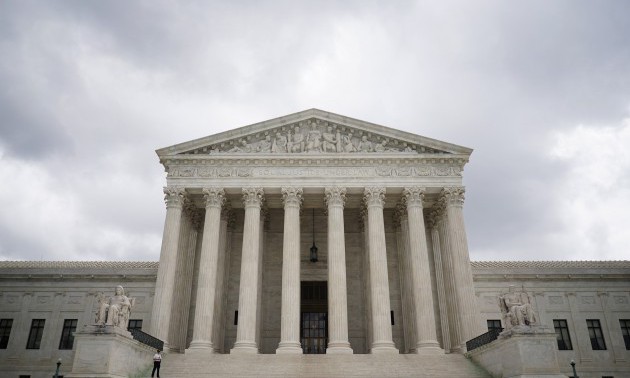University Of Texas Affirmative Action Supreme Court Case
Stay Woke: Everything You Need To Know About The 2 Supreme Court Cases Affecting Black Women This Week
What will be the fate of voting rights and affirmative action for people of color in the months ahead?
Share the post
Share this link via
Or copy link


Source: MANDEL NGAN / Getty
In case you haven’t noticed, this is a really important week for people of color in the cases on voting rights and affirmative action that are currently under review by the Supreme Court. How our Supreme Court justices decide on these cases could have huge and negative impacts on our voting power as well as our chances of college admission.
Here are the details on these current Supreme Court cases that America’s Black women should be watching and talking about in the months ahead:
Political Representation For America’s Most Vulnerable Is At Risk In Evenwel v. Abbott

Source: Richard Ellis / Stringer / Getty
Supreme Court Justices are revisiting the “one person, one vote” principle in asking if state districts should count all residents or just eligible voters in the Evenwel v. Abbott case.
Love HelloBeautiful? Get more! Join the HelloBeautiful Newsletter
We care about your data. See our privacy policy.
The issue here is that reducing district counting to only those eligible to vote further marginalizes groups that are already disadvantaged or ineligible for the franchise. This includes undocumented immigrants, children and convicts—groups that are already often concentrated in urban areas. What’s more, counting all residents is important to ensure that politicians are representative of everyone, including those who can’t make a ballot.
The additional challenge of changing states’ voting practice is that the census is the only constitutionally required data that is pulled to profile populations. The census counts everyone regardless of their voter status; there has yet to be similar data pulled that is just for eligible voters.
Having these disenfranchised groups counted in voting districts strengthens voting power for Democrats. Doing the opposite advances Republicans because conservatives have higher percentages of eligible voters.
Most states and localities currently count all residents when creating voting districts. The case was waged by the Project on Fair Representation, a small conservative advocacy group. The plaintiffs who waged the case were concerned that their districts were overpopulated and that eligible voters were getting multiple votes. The decision expected to be reached in June.
The Supreme Court has yet to make an official ruling on who should be counted, as “one person one vote.” That voting principle currently only counts for the whole US political system, the Senate being the only exception.
UP NEXT: Affirmative Action Is Under Attack Again In U of Texas Case
Abigail Fisher Trolls Us Again In Fisher V. University of Texas

Source: Mark Wilson / Getty
Remember Ms. Fisher, the young White woman who applied to University of Texas (UT) in 2008 and sued because she was rejected admission?
Well, the Supreme Court has resumed in her case now that an appeals court has ruled in favor of the university, saying that UT had constitutionally been using race as a determining factor in its admissions process. This essentially was a middle finger to Fisher who complains that she was rejected because she’s White and that she should have been given admittance over other students of color who were admitted with lower grades, standardized testing scores and/or involvement in extracurricular activities.
Fisher had applied to the university in its program that automatically grants admission to any public university that a student chooses if they graduate in the top 10 percentile of their state. However, the university says that Fisher wasn’t actually in the top 10 percentile and that she was then considered in its “holistic review” process which looks at students’ overall profile to determine if they should be given acceptance. Race is one of the final determining factors that admissions counselors use to decide if a student will be accepted. Ultimately, it was decided that Fisher’s grades and test scores were too low for her to get into the school.
Fisher is justifying her case by saying the university’s holistic review is unconstitutional, as it conflicts with the Fourteenth Amendment’s Equal Protection clause. Supporters of Fischer add that affirmative action is outdated, ineffective and unfair to other students. Essentially, Fisher’s legal team’s goal is to get the court to decide that affirmative action isn’t tailored enough or necessary to the admissions process to produce a diverse population of students that are worth being on campus. Fisher’s legal team also argues that the university uses affirmative action as a cover up for accepting students of color with lower academic standing that come from wealthy families.
But UT’s lawyers are calling Fisher’s defense bs. Other White applicants with identical or lower scores were admitted that year while Black and Latino students with better scores were denied admittance, too. They also point out that students coming through holistic review generally have higher SAT scores than top 10 percenters. Finally, there’s no merit to Fisher’s case because she didn’t suffer any injury compelling enough to bring a case before Supreme Court justices—especially since she eventually graduated from another college, Louisiana State University.
The university’s lawyers explain that the 10 percentile program (which accounts for three-fourths of its student body) isn’t enough to provide diversity on campus because high schools are already highly segregated by race in Texas as a result of the way districts are drawn. As a result, the 10 percentile program is too one-dimensional to give students of diverse backgrounds a fair chance at acceptance.
This is why UT has the holistic review process to garner the remaining quarter of its student population. Holistic review allows for race to be considered in addition to applicants’ academic achievements and extracurricular activities. There’s hard evidence proving that including race as an explicit factor in admissions is crucial to creating diversity. In 1996 a prior court case had ruled that race couldn’t be used in admissions decisions, forcing counselors to use race-neutral practices in deciding on applicants during holistic review instead. As a result, the number of minority students dropped by a whopping 40 percent. UT’s student population was only made more diverse again when the decision had been reversed in 2003.
Fisher first filed her case with the Supreme Court in 2013. At the time, the justices issued a short opinion essentially saying the lower court that initially decided on Fisher’s case put too much faith into the university’s use of race for diversity. The justices then sent the case to an appeals court to determine if the university’s use of race was limited or defined enough to be valid in its admissions process.
The appeals court upheld previous decisions made in favor of the university. Given the opposing views of Justice Sonia Sotomayor versus her more conservative colleagues like Clarence Thomas and Antonin Scalia, the decision could go either way. If the court rules in favor of Fischer, it could limit public university’s use of race in consideration of applicants at other schools nationwide.
Justices are to decide on the case by next year. The case comes at a highly unusual time, as the country just witnessed a wave of protests, sit-ins and social media conversations highlighting the rampant discrimination and institutional racism that students of color face on predominantly White college campuses.
[SOURCES: Reuters, New York Times, CNN, NPR]
RELATED LINKS:
Chicago Cops Received 1-Day Suspensions After Tasering & Dragging Mentally Ill Man In Holding Cell
White House, GOP Join Forces Against Trump And His Raging Islamophobia
Daniel Holtzclaw’s Lawyers Blame Alleged Rape Victims Minutes Before The Jury Meets For The Case





